A difficult choice that many people face when they are in Laos and intend to travel to Vietnam is how exactly to do this. Laos borders Vietnam to the east, so crossing the border on land seems logical in the same way as crossing the border from Thailand to Laos. Unfortunately, the roads in Laos are not of the same standard as in Thailand and taking a bus or car in Laos is often risky. In addition, drivers in Laos and perhaps in Southeast Asia in general, are known to drive like savages. These factors often result in many choosing to fly from Laos to Vietnam. By air it will only take 1-2 hours, while 24 hours or more must be expected by bus. Airplanes are also far more comfortable than buses in terms of comfort. But it also comes with a higher price tag, often 3-4 times more expensive.
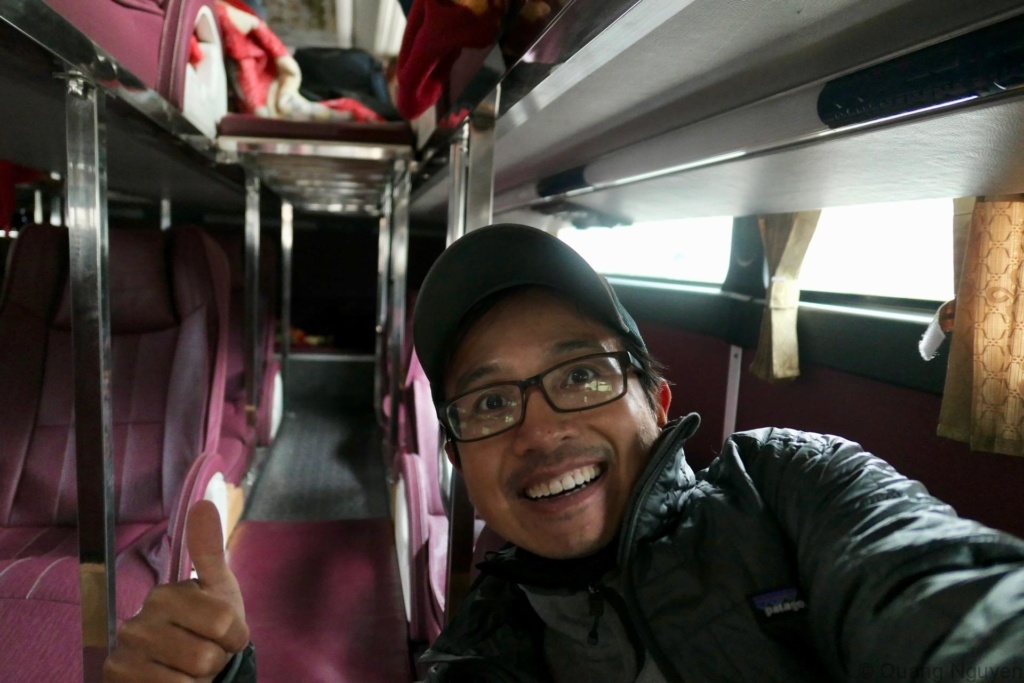
The bus trip from Luang Prabang to Hanoi has often been called “the ride from hell” according to a few blogs I’ve read. Many recommend that you take a flight instead and that the money you save is not worth the terrible experiences you will have. I have to be honest to admit that I was quite hesitant after reading the reviews about this trip. But the more I read, the more curious I became. What could really go wrong? I’m also Vietnamese and communication should not be a problem since I know the language – or at least as long as people speak Vietnamese! Besides, I really wanted to cross Vietnam on land to get that feeling of actually crossing the border on my own legs! After walking around and thinking about this for a couple of days in Luang Prabang, I decided to book a bus ticket to Hanoi! Since I am now writing this article, it means that I’ve survived the journey! I will try in this article to give you an insight into what this journey is really like, what you should prepare for and general things you should watch out for.
Ticket
It is very easy to get a bus ticket to Hanoi from Luang Prabang. You can find many tour operators especially around the night market area. It’s also possible to save some money by buying a ticket directly at the bus station. The disadvantage is that the station is approx. 4km south of the city centre. So the cost of the tuk-tuk to the bus station will probably make up the difference in the total price. I recommend that you book with a tour operator as the ticket often includes pickup from your hotel/hostel/guesthouse, so you don’t have to take a tuk-tuk or taxi to the bus station. The price for the bus ticket is plus/minus 38 USD depending on which operator you book from. As mentioned, the ticket includes pickup from your hotel/hostel.
There is a daily bus from Luang Prabang to Hanoi, which departs at 1800 in the afternoon. Most operators will advertise that the trip will take 24 hours, but this a truth with some modifications, as it will always take more time than stated. The fact that there will be delays is something to be expected when taking transport in South-East Asia, especially by bus. Since the trip will take over 24 hours, the buses that run this route will be so-called “sleeper bus”. These buses have sleeping seats instead of the sitting seats that you are used to. The sleeping seats are not quite straight though, as there is a slight incline of approx. 10 degrees. You can also raise the seat up to approx. 20-30 degrees so that you can sit. Another thing that is important to note is that there are no toilets on the bus! Although the bus will stop every 3-4 hours for a toilet break and food, it is important to make some preparations for this trip.
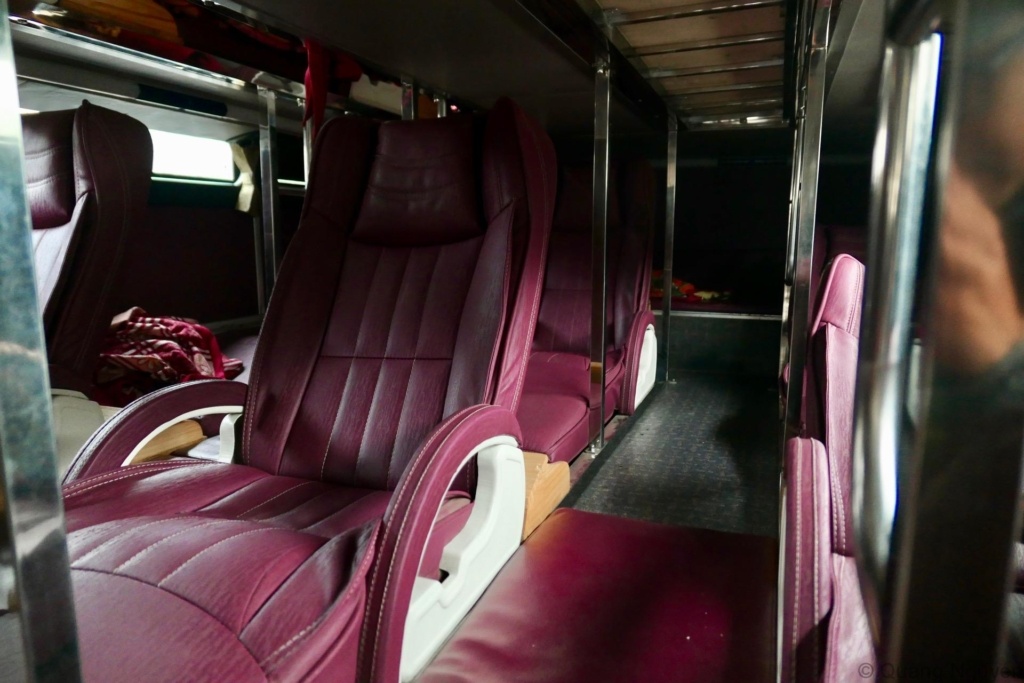
Food and drink
For my part, my preparations were mostly of the mental kind. I have read many horror stories about this bus trip and it is important to keep your mind focused on the fact that “anything can happen”. But at the same time, it is important to think that this is an adventure and an experience of a lifetime! The practical preparations I made included buying enough drink and food for the entire journey. Although the bus will stop at several places along the way where you can buy food, it is probably safest not to eat any food at these restaurants, as the hygiene is probably worse than at tourist places. You simply don’t want to get food poisoning on a bus that doesn’t have a toilet! The food I bought for the trip was dried bananas and sweet potatoes. These are more snacks than real food, but they fill the stomach well at the same time as being a healthy snack! In addition, it is important to bring enough drinks, but at the same time not to drink too much during the bus journey, precisely because of the lack of toilets. I think if you really need to go to the toilet you can ask the driver to stop on the side of the road, but it’s a bit boring to have everyone on the bus waiting for you. Because the departure time is at 1800 in the afternoon, it is also important to eat an early dinner. But feel free to eat things that you are sure of and not something that can give you digestive problems.
Clothes and miscellaneous
Even if you will be given a blanket on the bus, it is important to bring with you long trousers and a sweater/jacket on the bus, as the air conditioning in the bus is often on maximum and it can get quite chilly. I took this bus at the end of January and the climate was quite cold especially when you closer to Hanoi. In addition, make sure you have a sleeping mask and earplugs! Feel free to bring audio books or music and the time will surely go faster!
Visa
To come to Vietnam you need a Visa. I had already made a visa in Thailand which was valid for 90 days. The visa cost almost NOK 1000/100USD, so I recommend getting a visa in your own country before traveling to Vietnam, as it is much cheaper than in Thailand. If you intend to stay in Vietnam for less than 14 days, you can get a free visa on arrival (visa-on-arrival) at the border, but this applies only for certain countries.
Money
You should spend all the Kip (Laos money) before crossing over to the border into Vietnam. Kip is pretty useless in Vietnam and it’s also a bit hard to find places that exchanges to Vietnamese Dong. I also don’t recommend exchanging Vietnamese Dong in Luang Prabang as you will get a pretty bad rate there. It’s better that you get a few dollars so that you have as “backup” money in case something happens during the trip. I always have 100 USD with me. The USD is highly valued in South East Asia and can often be used instead of the local currency.
The journey starts – in the bus
Then the day of departure had arrived. I was picked up by tuk-tuk from my hostel around 1700. The tuk-tuk then drove on to pick up other travelers who had also booked the same journey.
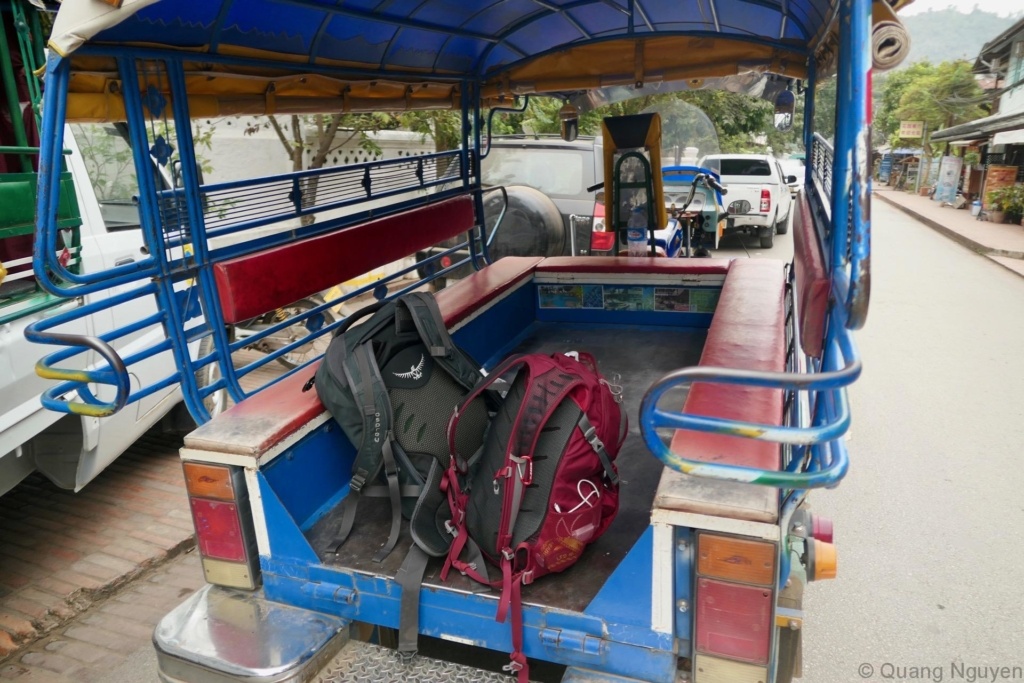
After about half an hour we arrived at the bus station, which is located approx. 4km south of the city. After arrival, we were asked by the staff at the station to convert the ticket we had received into a “valid” bus ticket. This is done by going to the ticket booth where I handed in my passport and ticket. After a short while I got back my passport and the valid ticket. So it was this ticket that I had to show to the bus crew to board the bus. A general tip when taking a bus in Asia is to always take important possessions with you, such as passports, money etc. into the bus. The rest can be kept in the trunk. I therefore always bring with me my day-backpack containing my important belongings into the bus.
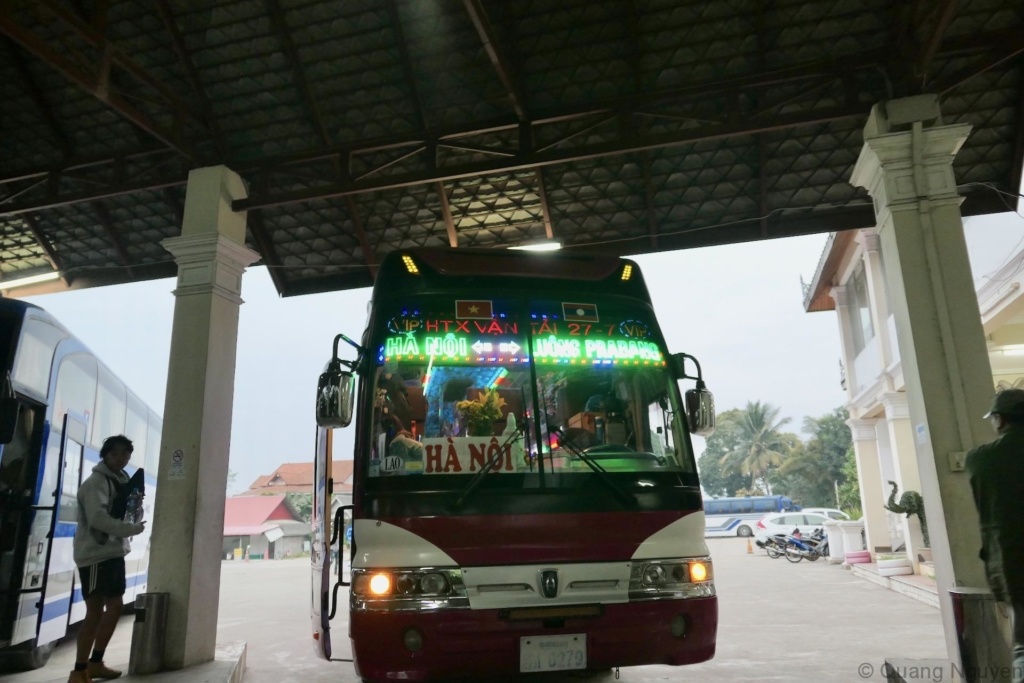
The first thing you notice when you get on board the sleeper bus is that there are 3 rows of seats, where 2 seats are bunked up in each row. As I recalled it, we were not given a seat number, but were only directed to the seat we were to lie down. Lying on the top seat has the advantage that you have a fairly large window and can enjoy the view. The disadvantage is that you have to climb up and down when getting on/off the bus.
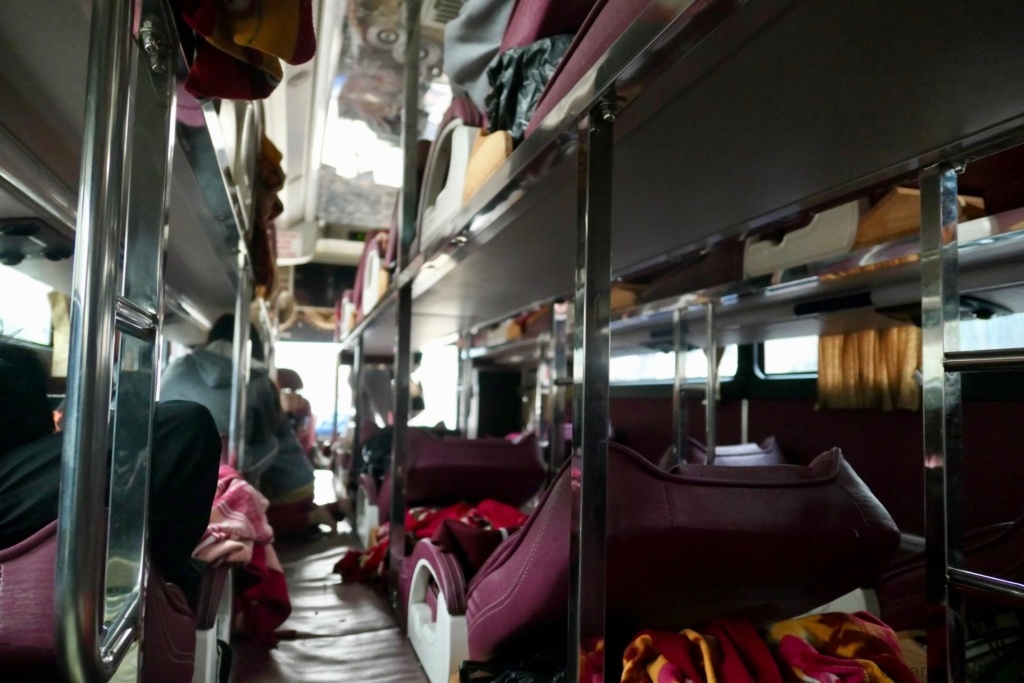
The bottom seat, which I got, has a very limited view, but has the advantage of not having to climb up and down. In my opinion, the seats are very comfortable to lie on, even if they are not quite straight. However I can imagine that those with long legs may struggle a bit with space. There was, for example, nowhere to put my small backpack and I had to place it between my legs. Another thing that everyone had to do before boarding the bus was to take off their shoes and put them in a plastic bag. This bag was taken on board the bus.
For some strange reasons, these sleeper buses are often equipped with disco lights in the bus. After boarding I got the feeling of having arrived in a party bus or a disco bar. There was also quite loud Vietnamese music playing as well. But luckily the driver turned off both music and lights shortly after departure.
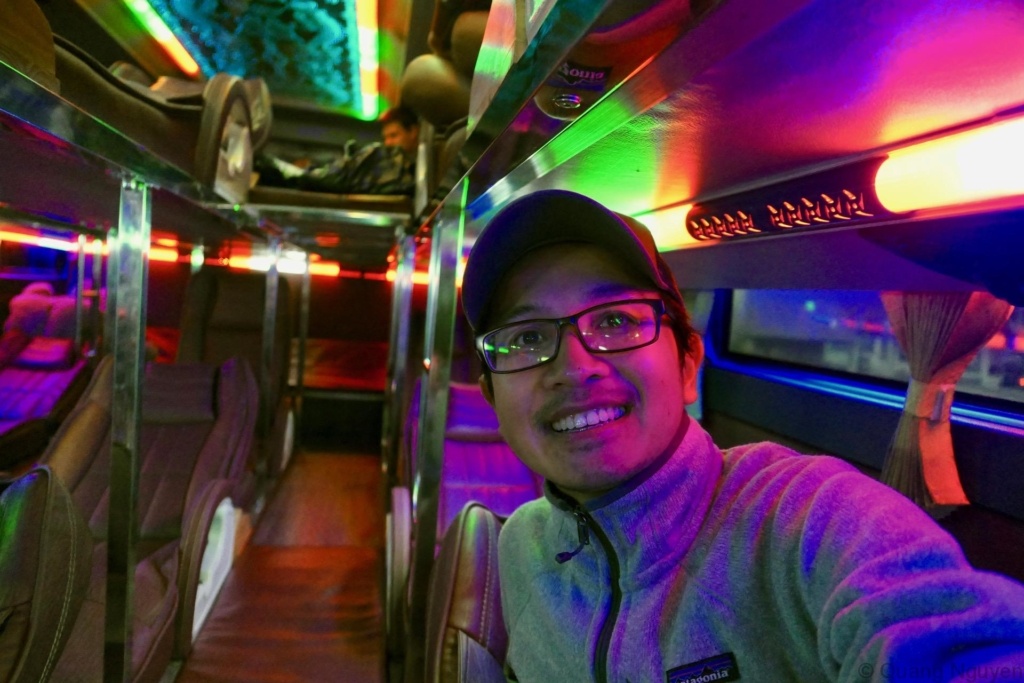
I’d heard stories where the bus driver usually takes strong medication to stay awake in order to drive the long distances. There have also been several cases where this ended in traffic accidents. It was therefore reassuring to discover that the bus I took had not just one but three drivers. They took turns driving so one of them could rest.
After settling into my seat, I put on a sleeping mask and earplugs and fired up an audiobook. With this set up I felt that I was quite comfortable and could sleep. Although the roads in Laos are quite bad and you will notice that the bus shakes quite a lot, it wasn’t so bad that you couldn’t sleep. The worst part, however, was all the constant honking that the driver did. Honking in South-East Asia is very common and the purpose of it is to let other road users know that you are on the road. But with earplugs it wasn’t as bad.
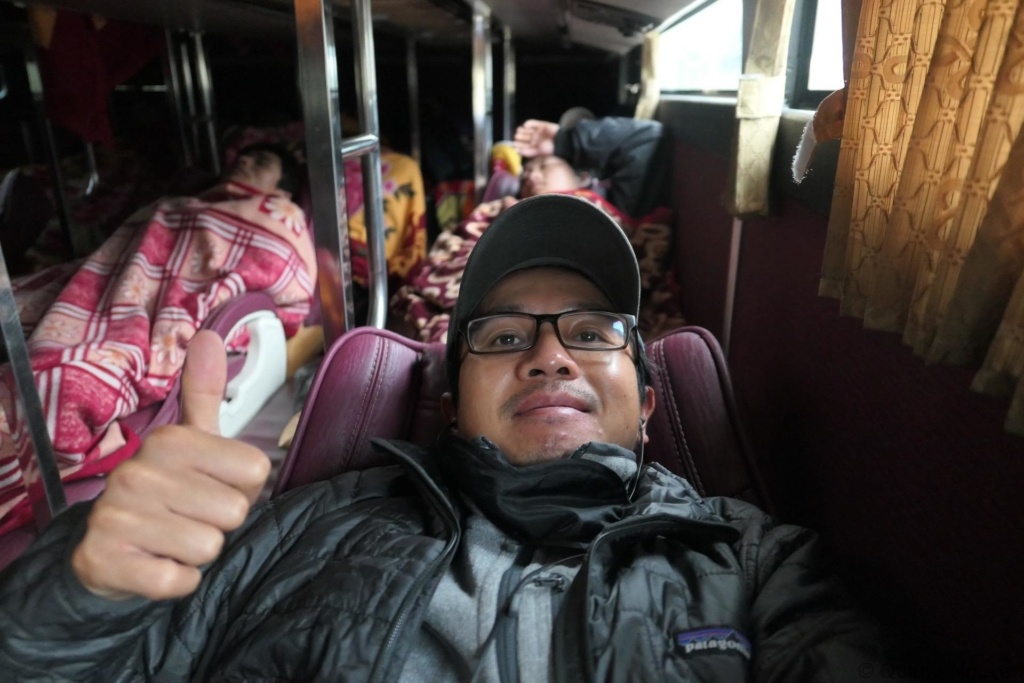
I also noticed that it got quite chilly in the bus after a while and even though we were given a blanket, it wasn’t enough to keep me warm. I then had to put on both a sweater and a bubble jacket in addition to the blanket. I was also wearing sweatpants.
Arrival at the border
The bus picked up more and more passengers along the road towards the border with Vietnam. These were mostly either Laotions or Vietnamese. Before we got to the border, the bus was full and there were some people lying along the aisle in the bus. This made it a bit difficult to get in/out of the bus as I had to climb over these people. The bus also made a couple of toilet stops before we arrived at the border, which is called Nam Can. We arrived at the border at 0600 the next morning. The trip had then passed without significant incidents and I slept for most of the time. Since the border doesn’t open until 0700, the bus stopped at the border and waited there. It was probably the best hour of the whole trip, as there was no shaking, noise and honking!
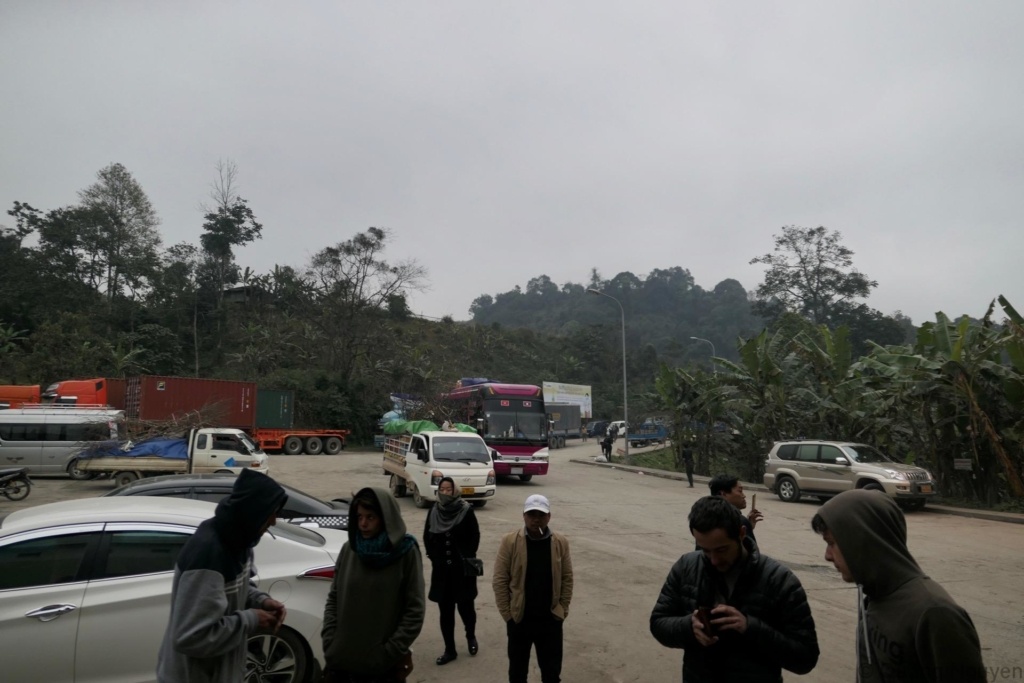
When the clock struck 0700, the driver asked all foreigners to get off the bus, collect their luggage and then go to a building on the Laotian side of the border to stamp out of the country. Stamping was a straightforward affair, as all you had to do was hand in your passport and a completed exit form (which you received when you arrived in the country) to the person at the counter. If you do not have this form or have lost it, you must ask for a new form and then fill it in.
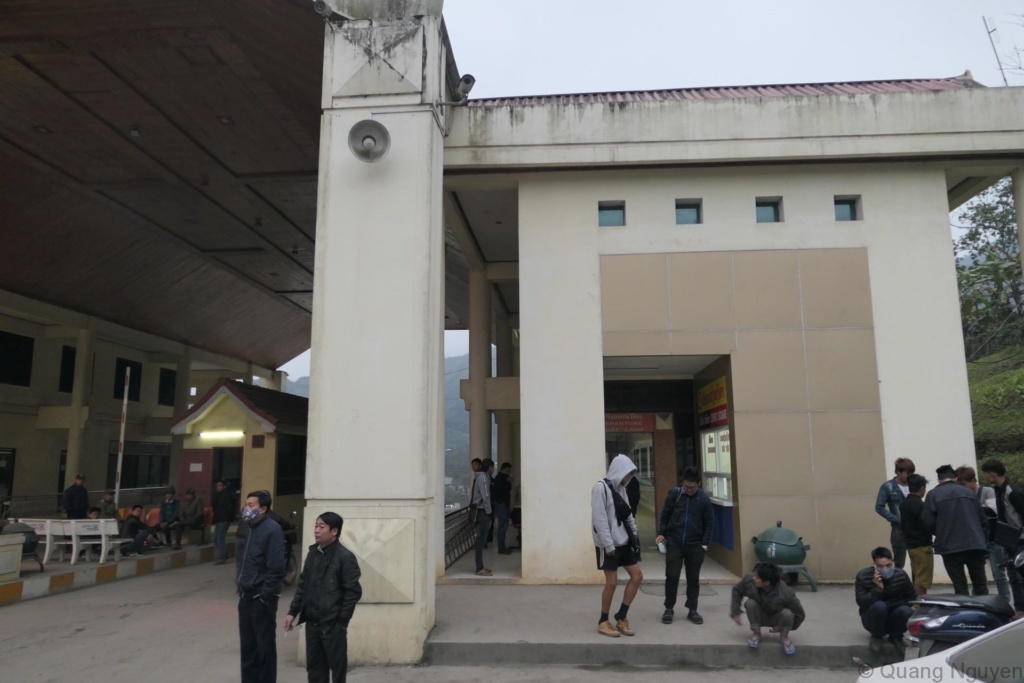
When the stamping was done I walked out of the office and then across a small bridge that leads to the Vietnamese side of the border! Just after the bridge, you could see a building that says Immigration. So it was here that you were stamped into the country. However, I was not even allowed to enter the building and had to wait outside. After a few minutes of waiting, I was told to enter the building. By then, the entire group of foreigners from the bus had also gathered in this building.
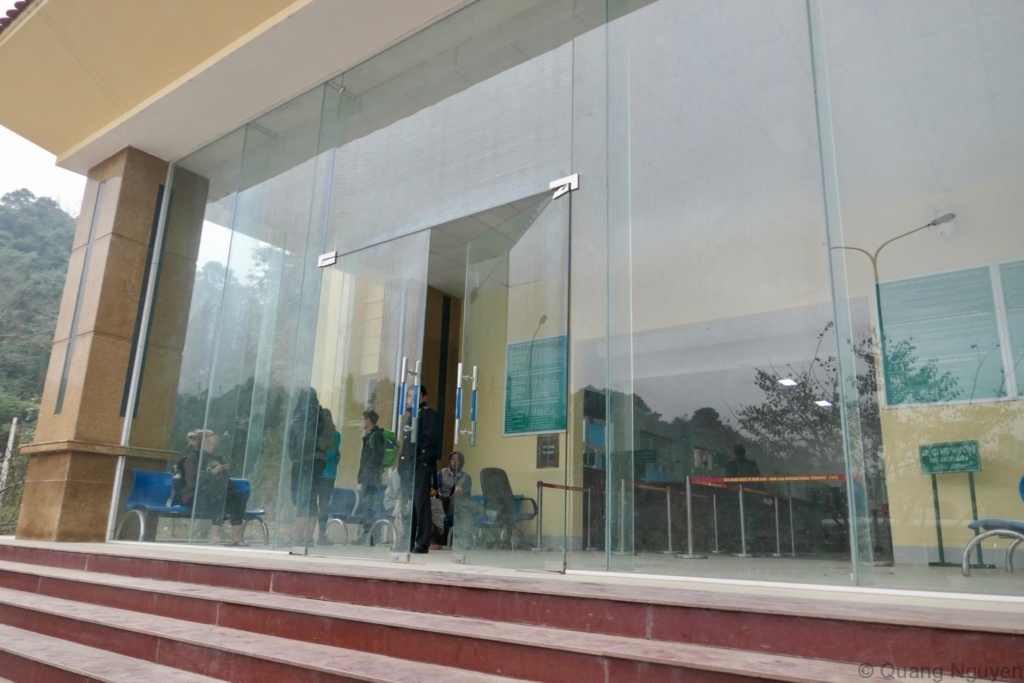
Similar to check-out from the Laotian side, check-in on the Vietnamese side was also quite painless. I handed my passport (with a 90 day visa) to a gentleman at the counter and a few minutes later I got my stamped passport back! Right next to the counter there was a scanner machine where I was asked to place my luggage for scanning. To be honest, I don’t know if the machine actually worked or not and the operators there seemed pretty slack – maybe it was still early in the day?
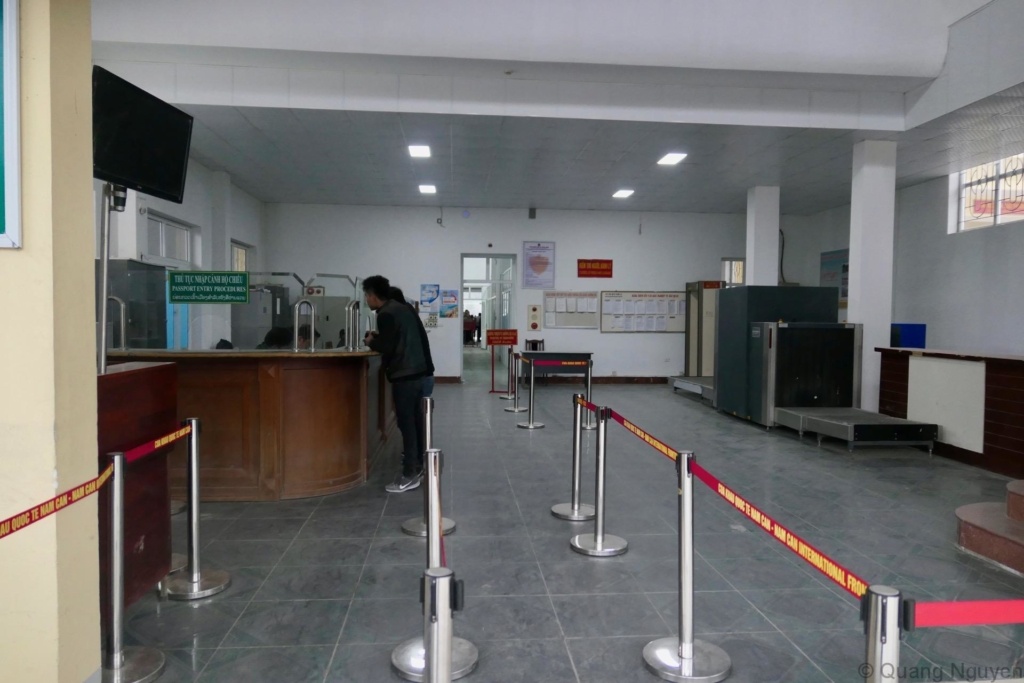
Anyway, after the luggage scanning I followed the “exit” sign and walked out of the building. I am now officially in Vietnam and half the journey was done!
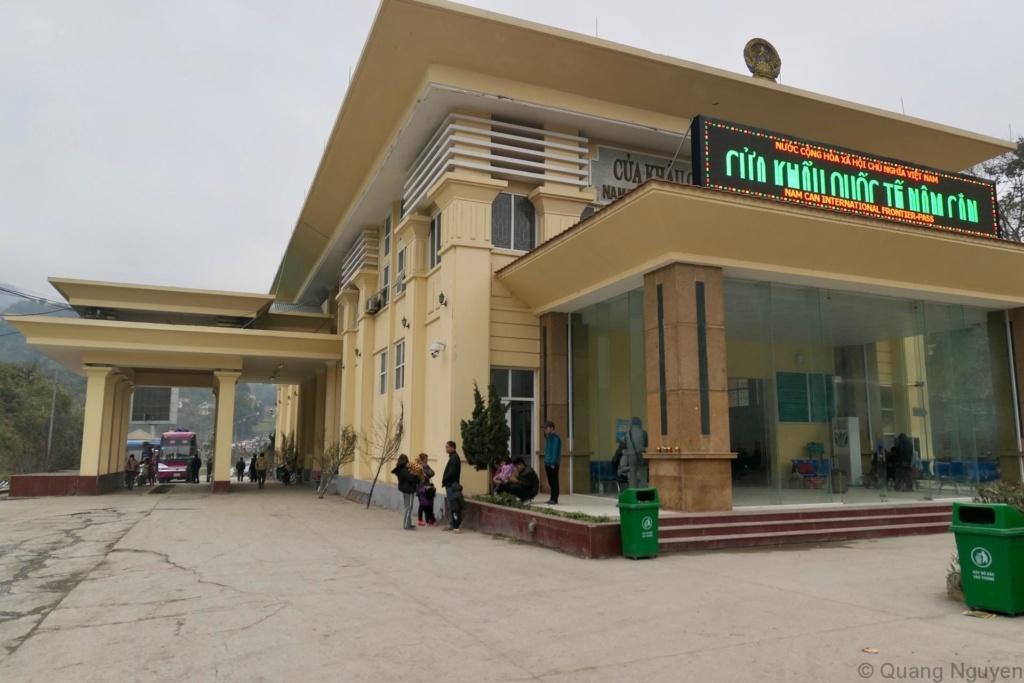
From the border, the bus continued towards Hanoi. The road seemed a little better in Vietnam, but the driver kept on honking. Around 1300, the bus stopped at a restaurant and it was here that you had the opportunity to get proper food and go to the toilet. I didn’t take the chance to eat here, but noticed that most people from the bus did. We stopped there for approx. half an hour.
Unexpected bus change
Around 100km from Hanoi we were told to change buses. This applied to everyone going on to Hanoi. I was very surprised by this, as I did not know that we had to change buses. The tour operator where I booked the ticket had not mentioned this, nor the blogs I had read beforehand. Hesitantly, we got off the bus and collected our luggage. Fortunately, a smaller bus arrived quite immediately and parked next to the bus from Luang Prabang. We were told to collect our luggage and get on the small bus.
This small bus is a kind of local bus, but was very comfortable. The bus was spacious and had good seats. But because it is a local bus, the bus stopped as soon as it sees someone waving for the bus on the road! And so the bus continued like this all the way to Hanoi. After a while, the bus was packed and the crew started placing plastic chairs along the corridor so that people could sit. We were lucky as we got on board early, so that the whole group from the Luang Prabang got a seat.
Arrival in Hanoi
After 2 long hours on the local bus we arrived at the main bus station in Hanoi. This bus station is approx. 6 km from the center and we had to get transport to the city. When we got off the bus, we were greeted by a bunch of taxi drivers, both moped taxis (“xe om” in Vietnamese) and regular taxis who wanted to offer us transport. Luckily I knew the language and managed to arrange a transport for 5 people for 200k Dong to the Old Town (tourist district) of Hanoi. This corresponds to around NOK 70/7USD or around NOK 15/1,5USD per person. This was a good deal!
Conclusion
The entire bus trip from Luang Prabang in Laos to Hanoi took around 27 hours. I’d expected a ride from hell in advance, but found the bus ride to be pleasant without any problems or difficulties. If I had the choice to take the bus or fly again, I would without hesitation choose the former again. For me it was an adventure and an experience. Such a trip also gives you insight into how the locals travel. You also get to enjoy the beautiful scenery along the way. So don’t be afraid, take the bus!
Vlog:
Location: